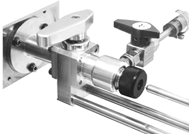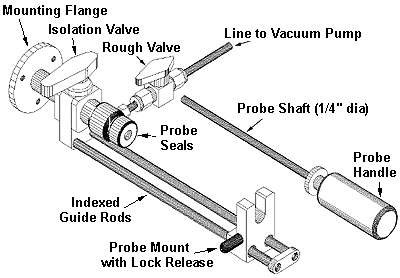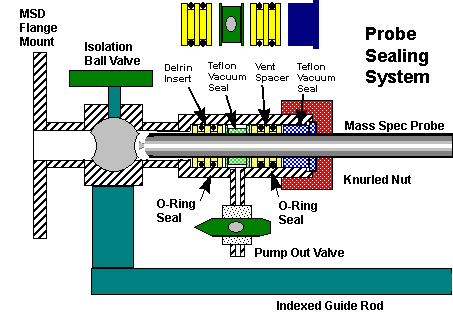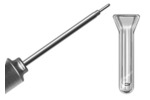- ▶
- Heaters/Source
- ▶
- Agilent Heaters and SensorsMass Spectrometry, Scientific Supplies & ManufacturingScientific Instrument Services 5973 Source Heater Tamper Resistant Allen Wrench 5973/5975 Quad Sensor 5985 Source Heater Assembly Agilent Interface Heater Assembly 5971 Interface Heater

- ▶
- Reference Material on InstrumentationArticle - A High Temperature Direct Probe for a Mass Spectrometer Design of a Direct Exposure Probe and Controller for use ona Hewlett-Packard 5989 Mass Spectrometer SIS AP1000 AutoProbe™ SIS AP2000 AutoProbe™ - Description of System HPP7: Direct Probe Electronics Console HPP7: Direct Probe for the Agilent (HP) 5973/5975 MSD HPP7: HP Direct Probe Application Notes HPP7: Installation Directions for the Direct Probe HPP7: Side Cover for the HP 5973 MSD HPP7: Support HPP7: Probe Inlet System for the Agilent (HP) 5973 and 5975 MSD with Automatic Indexed Stops HPP7: Theory of Operation of the Direct Probe and Probe Inlet System Direct Thermal Extraction Thermal Desorption Application Notes Environmental Thermal Desorption Application Notes Food Science Thermal Desorption Application Notes Forensic Thermal Desorption Application Notes GC Cryo-Trap Application Notes Headspace Application Notes Purge & Trap Thermal Desorption Application Notes Theory of Operation of the AutoDesorb® System AutoDesorb Notes for SIS Dealers Adsorbent Resin Application Notes Installation of the Short Path Thermal Desorption System on Agilent (HP) and Other GCs Installation of the Short Path Thermal Desorption System on a Varian 3400 GC AutoDesorb® System Development Team Thermal Desorption Applications and Reference Materials Installation of the Short Path Thermal Desorption System - TD5 Part I - Design & Operation of the Short Path ThermalDesorption System Installation Instructions for the Model 951 GC Cryo-Trap on the HP 5890 Series GC Installation Instructions for the Model 961 GC Cryo-Trap on the HP 5890 Series GC Operation of the Model 951/961 GC Cryo-Trap SIS GC Cryo Traps - Theory of Operation NIST/EPA/NIH Mass Spectral Enhancements - 1998 version (NIST98) SIMION 3D Ion Optics Class Mass Spectrometer Source Cleaning Methods MS Tip: Mass Spectrometer Source Cleaning Procedures Mass Spec Source Cleaning Procedures Micro-Mesh® Abrasive Sheets Research Papers Using New Era Syringe Pump Systems EI Positive Ion Spectra for Perfluorokerosene (PFK) Cap Liner Information How do I convert between fluid oz and milliliters? Which bottle material should I choose? Which bottle mouth should I choose? The Bottle Selection Guide CGA Connections for Gas Tanks Chemical Reaction Interface Mass Spectrometry (CRIMS)

- Probes
- LiteratureApplication Notes Adsorbent Resins Guide Mass Spec Tips SDS Sheets FAQ MS Calibration Compound Spectra Manuals MS Links/Labs/ Organizations MS Online Tools Flyers on Products/Services Scientific Supplies Catalog About Us NextAdvance Bullet Blender® Homogenizer Protocols Micro-Mesh® Literature Instrumentation Literature Agilent GC/MS Literature SIS News / E-Mail Newsletter NIST MS Database - Update Notifications

- ▶
- HPP7: Probe Inlet System for the Agilent (HP) 5973 and 5975 MSD with Automatic Indexed Stops (This Page)

- Three Position Indexed Probe Guide
- Easy Installation and Removal
- Mounts on the MSD GC Inlet Port
- Dual PTFE Long-Life Probe Vacuum Seals
- 1/4 Turn Roughing and Isolation Valves
- Edwards Roughing Pump

Probe Inlet System Parts
The SIS Probe Inlet System mounts on the GC/MS Transfer line port on the Agilent 5973/5975 MSD to permit the quick and easy introduction of the SIS 1/4" diameter direct probe through the MSD Vacuum manifold and into the MSD source. It incorporates an indexed dual guide rod system that accurately guides the probe through the vacuum system valves. The guide rods are indexed at three positions in addition to the fully inserted and fully extracted positions:
- Load - fully extended - probe load position
- Stop 1 - at the first vacuum seal - to permit the rough pump out of the probe inlet seals
- Stop 2 - at the second vacuum seal - to enable the user to open the isolation valve
- Stop 3 - 1 cm from the source - cooling position after the sample is finished
- Run - fully inserted - sample analysis Run position

After the probe locks in at one of the indexed stop positions, the lock release lever is pulled up to enable the probe to be inserted to the next indexed position. This accurate positioning and locking of the probe in set positions prevents closing the isolation valve on the probe (which would score or bend the probe rod). The most important automatic locking of the probe position occurs when the probe locks into the second seal position (Stop 2) during probe removal from the vacuum system. At this step the probe locks into the Stop 2 position thereby preventing the inadvertent venting of the mass spec vacuum system.
The probe sealing system consists of the SIS dual PTFE sealing system which will provide for excellent vacuum sealing around the probe rod along with long seal life. If the seals need to be replaced a seal extraction tool is included which enables the quick removal and replacement of the seals without venting the MSD. The 1/4" turn ball isolation valve permits the introduction of the probe through this valve and into the MSD source.



